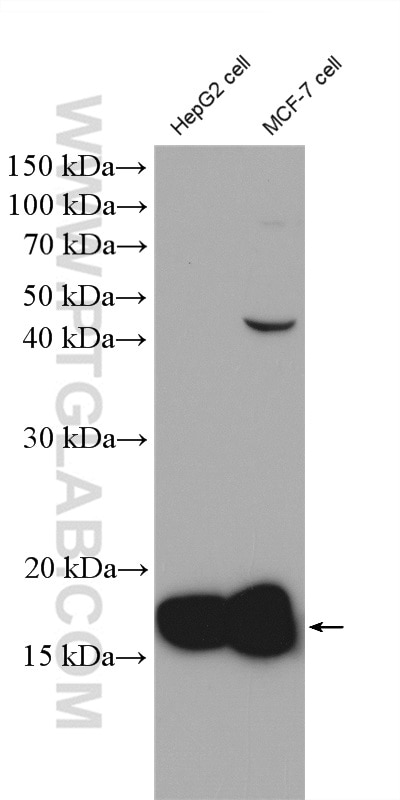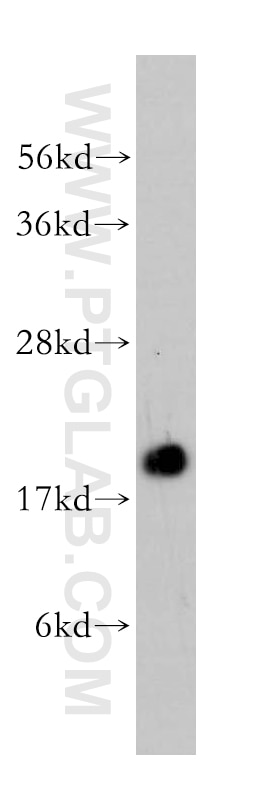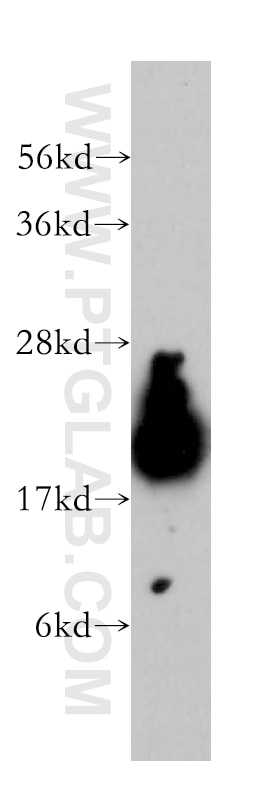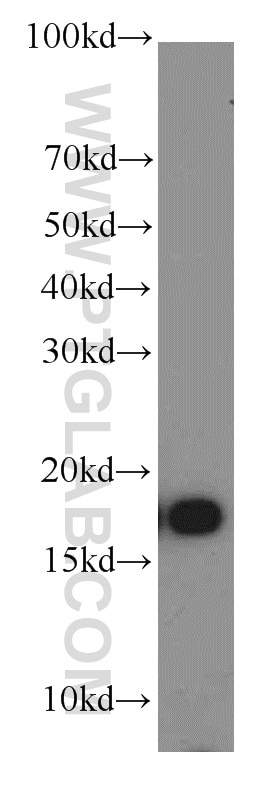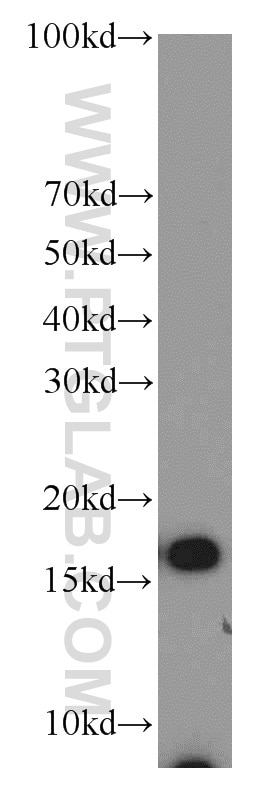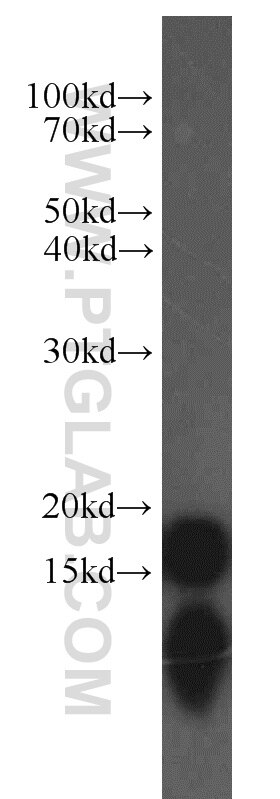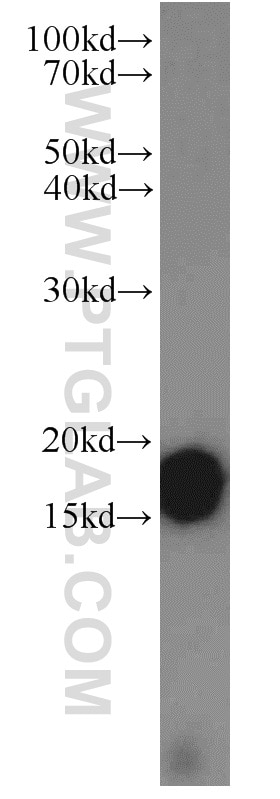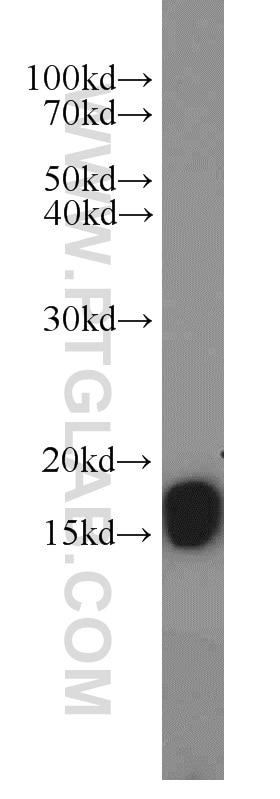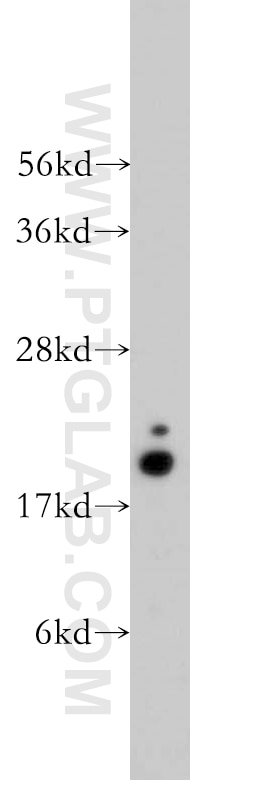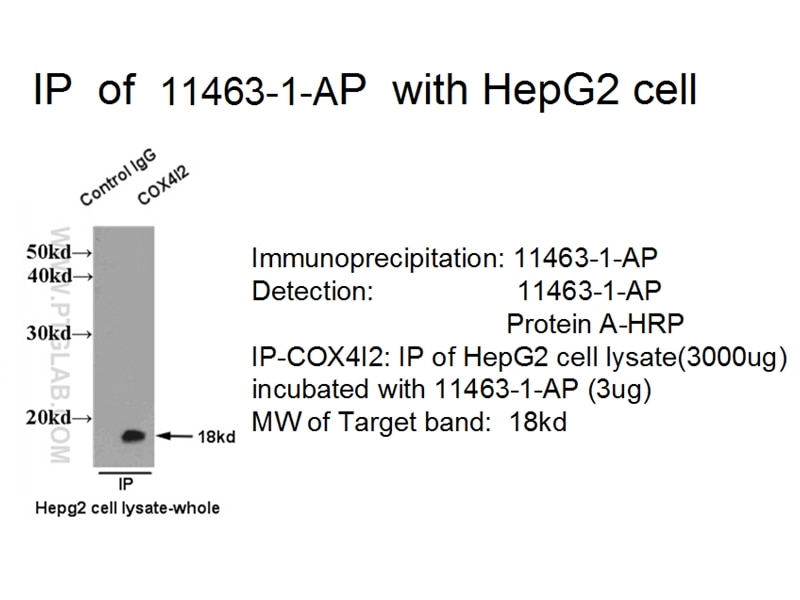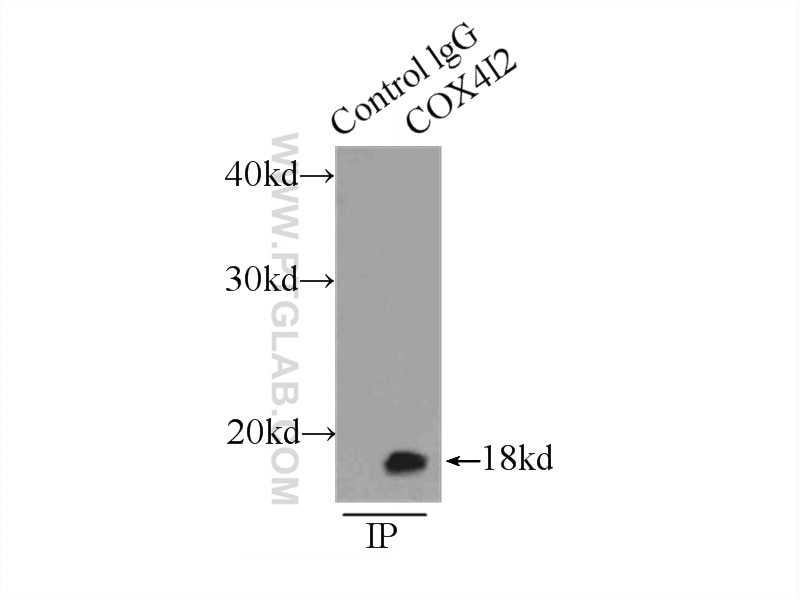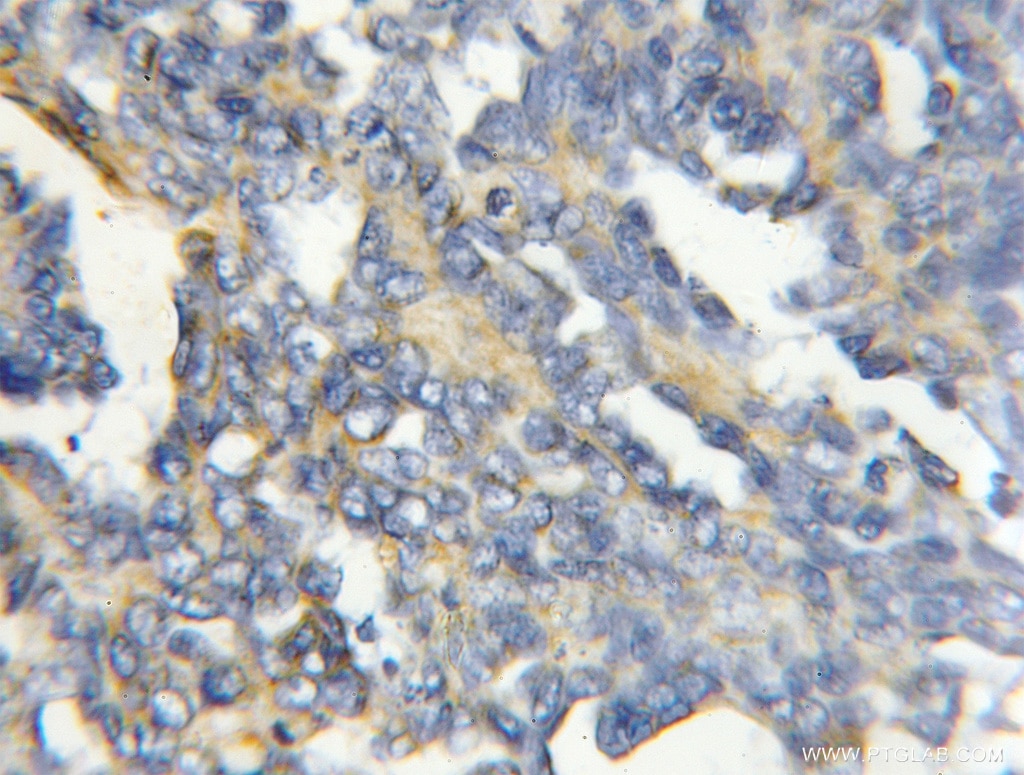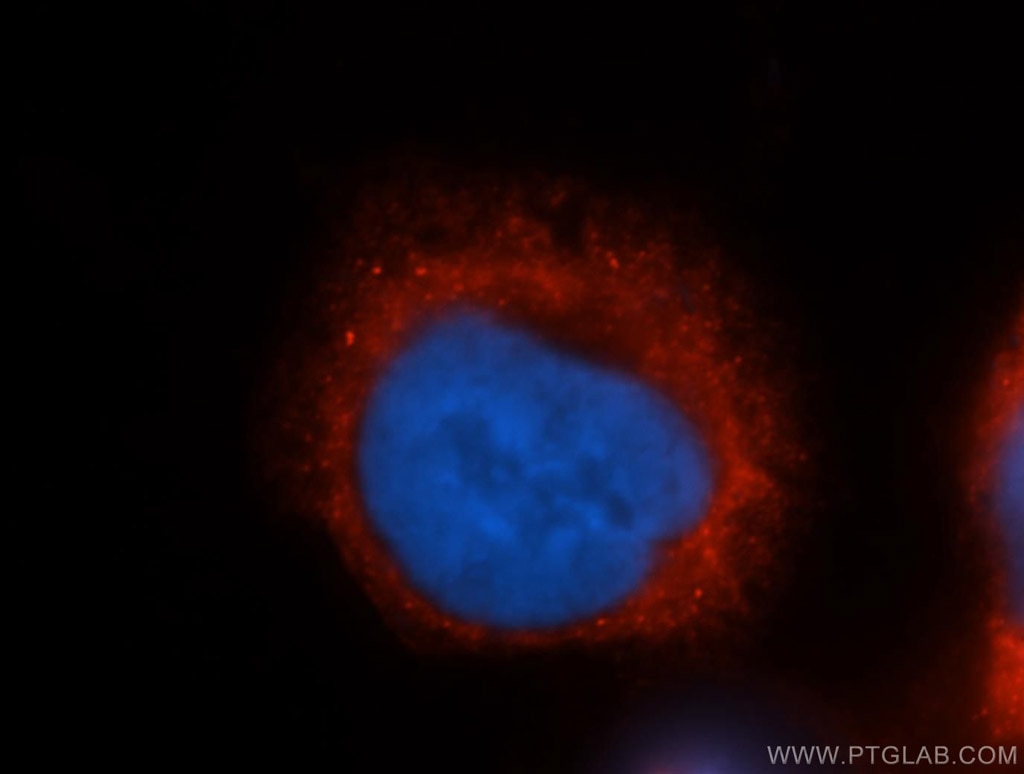- Featured Product
- KD/KO Validated
COX4I2 Polyklonaler Antikörper
COX4I2 Polyklonal Antikörper für WB, IHC, IF/ICC, IP, ELISA
Wirt / Isotyp
Kaninchen / IgG
Getestete Reaktivität
human, Maus, Ratte
Anwendung
WB, IHC, IF/ICC, IP, ELISA
Konjugation
Unkonjugiert
Kat-Nr. : 11463-1-AP
Synonyme
"COX4I2 Antibodies" Comparison
View side-by-side comparison of COX4I2 antibodies from other vendors to find the one that best suits your research needs.
Geprüfte Anwendungen
| Erfolgreiche Detektion in WB | HepG2-Zellen, A375-Zellen, humanes Herzgewebe, humanes Hirngewebe, humanes Lungengewebe, MCF-7-Zellen |
| Erfolgreiche IP | HepG2-Zellen |
| Erfolgreiche Detektion in IHC | humanes Ovarialkarzinomgewebe Hinweis: Antigendemaskierung mit TE-Puffer pH 9,0 empfohlen. (*) Wahlweise kann die Antigendemaskierung auch mit Citratpuffer pH 6,0 erfolgen. |
| Erfolgreiche Detektion in IF/ICC | HeLa-Zellen |
Empfohlene Verdünnung
| Anwendung | Verdünnung |
|---|---|
| Western Blot (WB) | WB : 1:500-1:3000 |
| Immunpräzipitation (IP) | IP : 0.5-4.0 ug for 1.0-3.0 mg of total protein lysate |
| Immunhistochemie (IHC) | IHC : 1:20-1:200 |
| Immunfluoreszenz (IF)/ICC | IF/ICC : 1:20-1:200 |
| It is recommended that this reagent should be titrated in each testing system to obtain optimal results. | |
| Sample-dependent, check data in validation data gallery | |
Veröffentlichte Anwendungen
| KD/KO | See 3 publications below |
| WB | See 12 publications below |
| IHC | See 4 publications below |
| IF | See 4 publications below |
Produktinformation
11463-1-AP bindet in WB, IHC, IF/ICC, IP, ELISA COX4I2 und zeigt Reaktivität mit human, Maus, Ratten
| Getestete Reaktivität | human, Maus, Ratte |
| In Publikationen genannte Reaktivität | human, Maus, Ratte |
| Wirt / Isotyp | Kaninchen / IgG |
| Klonalität | Polyklonal |
| Typ | Antikörper |
| Immunogen | COX4I2 fusion protein Ag1987 |
| Vollständiger Name | cytochrome c oxidase subunit IV isoform 2 (lung) |
| Berechnetes Molekulargewicht | 171 aa, 20 kDa |
| Beobachtetes Molekulargewicht | 17-18 kDa |
| GenBank-Zugangsnummer | BC057779 |
| Gene symbol | COX4I2 |
| Gene ID (NCBI) | 84701 |
| Konjugation | Unkonjugiert |
| Form | Liquid |
| Reinigungsmethode | Antigen-Affinitätsreinigung |
| Lagerungspuffer | PBS mit 0.02% Natriumazid und 50% Glycerin pH 7.3. |
| Lagerungsbedingungen | Bei -20°C lagern. Nach dem Versand ein Jahr lang stabil Aliquotieren ist bei -20oC Lagerung nicht notwendig. 20ul Größen enthalten 0,1% BSA. |
Hintergrundinformationen
COX4I2, also named as COX4L2 and COXIV-2, belongs to the cytochrome c oxidase IV family. It is one of the nuclear-coded polypeptide chains of cytochrome c oxidase, the terminal oxidase in mitochondrial electron transport. COXIV(cytochrome c oxidase IV) has two isoforms (isoform 1 and 2). Isoform 1(COX4I1) is ubiquitously expressed and isoform 2 is highly expressed in lung tissues. This antibody was generated against full length COX4I2 protein.
Protokolle
| Produktspezifische Protokolle | |
|---|---|
| WB protocol for COX4I2 antibody 11463-1-AP | Protokoll herunterladen |
| IHC protocol for COX4I2 antibody 11463-1-AP | Protokoll herunterladen |
| IF protocol for COX4I2 antibody 11463-1-AP | Protokoll herunterladen |
| IP protocol for COX4I2 antibody 11463-1-AP | Protokoll herunterladen |
| Standard-Protokolle | |
|---|---|
| Klicken Sie hier, um unsere Standardprotokolle anzuzeigen |
Publikationen
| Species | Application | Title |
|---|---|---|
Cell Rep Defective Mitochondrial Cardiolipin Remodeling Dampens HIF-1α Expression in Hypoxia. | ||
Oncotarget Nuclear-encoded cytochrome c oxidase subunit 4 regulates BMI1 expression and determines proliferative capacity of high-grade gliomas.
| ||
Sci Signal Acute O2 sensing through HIF2α-dependent expression of atypical cytochrome oxidase subunits in arterial chemoreceptors.
| ||
Free Radic Biol Med Cytochrome c oxidase mediates labile iron level and radioresistance in glioblastoma. | ||
Bioconjug Chem GnRH-Gemcitabine Conjugates for the Treatment of Androgen-Independent Prostate Cancer: Pharmacokinetic Enhancements Combined with Targeted Drug Delivery. | ||
Free Radic Biol Med Differentiation of SH-SY5Y cells to a neuronal phenotype changes cellular bioenergetics and the response to oxidative stress. |
